Marine vertebrate
Marine vertebrates are
Marine vertebrates can be divided into two groups, marine fish and marine tetrapods.
Marine fish
| Part of a series of overviews on |
| Marine life |
|---|
 |
Fish fall into two main groups:
Jawless fish
-
Lampreys are often parasitic and have a toothed, funnel-like sucking mouth
-
The extinctjawed vertebrates
Cartilaginous fish
Cartilaginous fish, such as sharks and rays, have jaws and skeletons made of cartilage rather than bone. Megalodon is an extinct species of shark that lived about 28 to 1.5 Ma. It looked much like a stocky version of the great white shark, but was much larger with fossil lengths reaching 20.3 metres (67 ft).[10] Found in all oceans[11] it was one of the largest and most powerful predators in vertebrate history,[10] and probably had a profound impact on marine life.[12] The Greenland shark has the longest known lifespan of all vertebrates, about 400 years.[13]
-
Cartilaginous fishes may have evolved fromspiny sharks
-
critically endangered[15]
-
The extinct megalodon resembled a giant great white shark
-
The Greenland shark lives longer than any other vertebrate
-
The largestextant fish, the whale shark, is now a vulnerable species
Bony fish
Bony fish have jaws and skeletons made of bone rather than cartilage. About 90% of the world's fish species are bony fish. Bony fish also have hard, bony plates called operculum which help them respire and protect their gills, and they often possess a swim bladder which they use for better control of their buoyancy.
Bony fish can be further divided into those with
-
Ray-finned fish (Prussian carp)
-
Lobe-finned fish)
(coelacanth
-
Pufferfish
-
Mandarin dragonet
Marine tetrapods

A
Marine tetrapods are tetrapods that returned from land back to the sea again. The first returns to the ocean may have occurred as early as the
Amphibians
Reptiles
Some reptiles are more closely related to
Except for some sea snakes, most extant marine reptiles are oviparous and need to return to land to lay their eggs. Apart from sea turtles, the species usually spend most of their lives on or near land rather than in the ocean. Sea snakes generally prefer shallow waters nearby land, around islands, especially waters that are somewhat sheltered, as well as near estuaries.[31][32] Unlike land snakes, sea snakes have evolved flattened tails which help them swim.[33]
-
Marine snakes have flattened tails
-
The ancientIchthyosaurus communisindependently evolved flippers similar to dolphins
Some
Birds
In general, marine birds live longer,
-
European herring gull attack herring schools from above
-
Gentoo penguin swimming underwater
-
Gannets "divebomb" at high speed
-
Albatrosses range over huge areas of ocean and regularly circle the globe.
The first marine birds evolved in the
Mammals

In a process of
-
Endangered blue whale, largest animal ever[39]
-
Humpback whale straining krill
-
encephalization of any animal after humans[40]
-
Walrus coming up for air
-
Battlingsea elephants
See also
- Marine habitat
- Marine invertebrate
- Marine life
References
- ^ "FishBase: A Global Information System on Fishes". FishBase. Retrieved 17 January 2017.
- ^ "How Many Fish In The Sea? Census Of Marine Life Launches First Report". Science Daily. Retrieved 17 January 2017.
- doi:10.1111/j.1095-8649.2006.00968.x (inactive 31 January 2024).)
{{cite journal}}: CS1 maint: DOI inactive as of January 2024 (link - ISBN 978-0-123-24801-5.
- S2CID 85969032.
- ^ "Myxini". University of California Museum of Paleontology. Archived from the original on 15 December 2017. Retrieved 17 January 2017.
- PMID 24560767.
- PMID 1496398.
- S2CID 35838285.
- ^ .
- PMID 20479893.
- S2CID 4369352.
- S2CID 206647043.
- Enrico de Lazaro (12 August 2016). "Greenland Sharks are Longest-Lived Vertebrates on Earth, Marine Biologists Say". Science News.
- .
- ^ Black, Richard (11 June 2007). "Sawfish protection acquires teeth". BBC News.
- ^ Clack, J. A. (2002) Gaining Ground. Indiana University
- ISSN 0024-1164.
- ISBN 978-0-375-42447-2.
- ISBN 978-0-520-26647-6.
- .
- PMID 19508493.
- S2CID 83659304.
- S2CID 88846435.
- S2CID 7041966.
- PMID 15545258.
- ISBN 978-0-19-857705-8.
- .
- ^ Modesto, S.P. (1999). "Observations of the structure of the Early Permian reptile Stereosternum tumidum Cope". Palaeontologia Africana. 35: 7–19.
- PMID 22087300.
- ISBN 0-448-11856-4.
- ^ Sea snakes[permanent dead link] at Food and Agriculture Organization of the United Nations. Accessed 7 August 2007.
- PMID 22087300.
- ^ Martill D.M. (1993). "Soupy Substrates: A Medium for the Exceptional Preservation of Ichthyosaurs of the Posidonia Shale (Lower Jurassic) of Germany". Kaupia - Darmstädter Beiträge zur Naturgeschichte, 2 : 77-97.
- ISBN 9780393311396.
- ^ "Sardine Run Shark Feeding Frenzy Phenomenon in Africa". Archived from the original on 2 December 2008.
- ^ "The Society for Marine Mammalogy's Taxonomy Committee List of Species and subspecies". Society for Marine Mammalogy. October 2015. Archived from the original on 6 January 2015. Retrieved 23 November 2015.
- ISBN 0030584469.
- ^ "Blue whale". World Wide Fund For Nature. Retrieved 15 August 2016.
- ^ Marino, Lori (2004). "Cetacean Brain Evolution: Multiplication Generates Complexity" (PDF). International Society for Comparative Psychology (17): 1–16. Archived from the original (PDF) on 16 September 2018. Retrieved 18 May 2019.

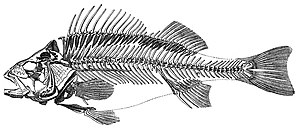

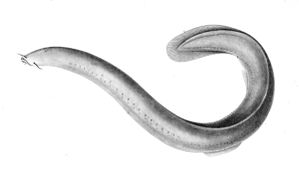



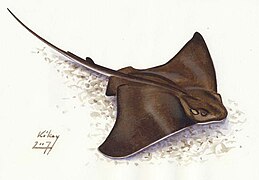
![The manta ray, largest ray in the world, has been targeted by fisheries and is now vulnerable.[14]](http://upload.wikimedia.org/wikipedia/commons/thumb/1/1d/Manta_ray_-_Chura-umi_Aquarium.jpg/237px-Manta_ray_-_Chura-umi_Aquarium.jpg)
![Sawfish are rays with long rostrums resembling a saw. All are now endangered or critically endangered[15]](http://upload.wikimedia.org/wikipedia/commons/thumb/4/48/Pristis_clavata_2.jpg/407px-Pristis_clavata_2.jpg)
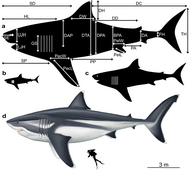
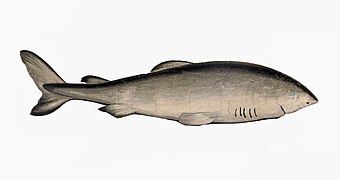


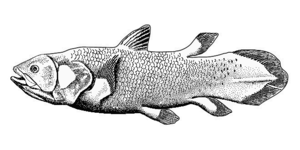
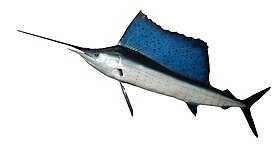


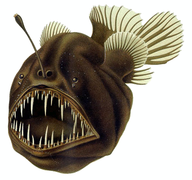

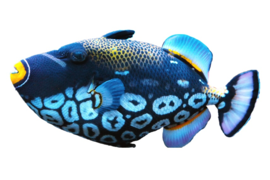
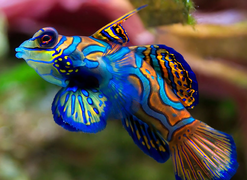

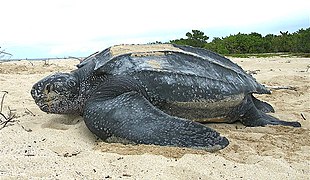

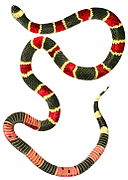
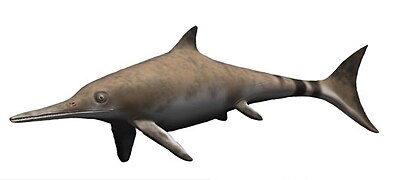

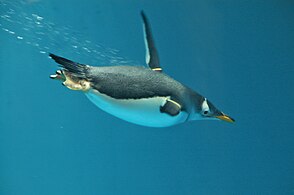
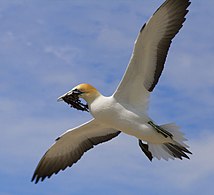
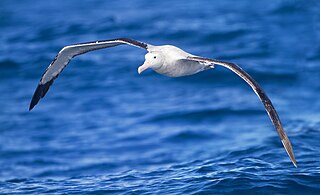
![Endangered blue whale, largest animal ever[39]](http://upload.wikimedia.org/wikipedia/commons/thumb/1/1c/Anim1754_-_Flickr_-_NOAA_Photo_Library.jpg/304px-Anim1754_-_Flickr_-_NOAA_Photo_Library.jpg)

![Bottlenose dolphin, highest encephalization of any animal after humans[40]](http://upload.wikimedia.org/wikipedia/commons/thumb/1/10/Tursiops_truncatus_01.jpg/318px-Tursiops_truncatus_01.jpg)





